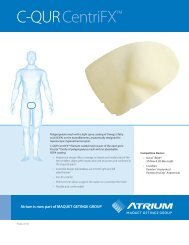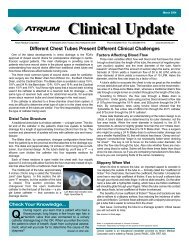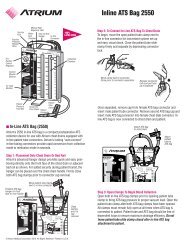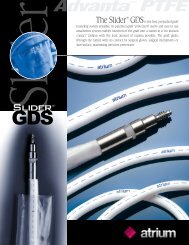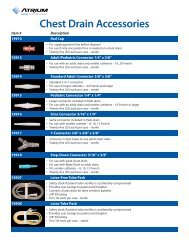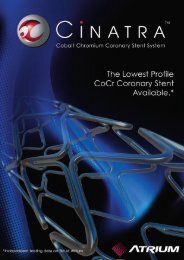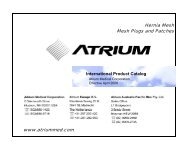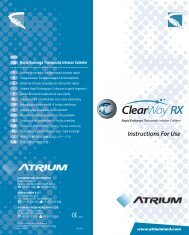Clinical Update - Atrium Medical Corporation
Clinical Update - Atrium Medical Corporation
Clinical Update - Atrium Medical Corporation
- No tags were found...
Create successful ePaper yourself
Turn your PDF publications into a flip-book with our unique Google optimized e-Paper software.
In The LiteratureAging and Shift Work: Keys to the NursingShortageAn article in a recent issue of Nursing Economic$ examines the ongoingnursing shortage from a unique perspective: how to manage roundthe-clockneeds with an aging workforce.According to author Elizabeth Ellen Cooper, hospitals need to work toretain experienced nurses while recruiting and training younger nurses. Inaddition, employers need to find ways to offset the negative impacts ofnight shift work, including providing sleeping areas, more flexible scheduling,job sharing, and more ergonomic working environments. She assertsthat retaining even two nurses at a facility (replacement cost, $60,000 pernurse) would more than offset the cost incurred for these improvementsbut concludes that more research is needed to explore these crucial issuesfor nurses and nursing practice.Source: Cooper EE: Pieces of the shortage puzzle: aging and shift work. NursingEconomic$ 2003;21(2):75-79.Family Presence: Benefit, Inconvenience, orHarm?Should family members be present when their loved one is beinggiven CPR or undergoing another invasive procedure? An article in thecurrent issue of the American Journal of Critical Care reports the results ofa survey of critical care and emergency room nurses. The 30-item surveywas mailed randomly to 1,500 members of the American Association ofCritical-Care Nurses and 1,500 members of the Emergency NursesAssociation. The survey consisted of demographic questions as well asqueries about the respondent's preferences, practices, and hospital policiesrelated to family presence during CPR and invasive procedures.Results showed that only 5% of respondents worked in units that hadwritten family presence policies. Despite the lack of any formal policy, familypresence was supported during CPR by 45% of nurses and during invasiveprocedures by 51%. Forty percent of those surveyed had escorted afamily member to the patient's bedside. About 25% reported barring familymembers during these procedures.Since only 5% of units had written policies, it is clear that nurses workingin all hospital areas need to develop clear policies and proceduresabout family presence. Perhaps a consultation with our colleagues in thedelivery room, who faced this issue many years ago, would be helpful. Thestudy authors call for more research into this important area and encourageunits to explore and develop written policies and guidelines that meetthe needs of nurses, patients, and families.Source: MacLean SL, Guzzetta CE, White C, Fontaine D, Eichhorn DJ, Meyers TA, andDesy P. Family presence during cardiopulmonary resuscitation and invasive procedures:practices of critical care and emergency nurses. American Journal of Critical Care2003;12(3):246-257.Strategies for Decreasing MedicationAdministration ErrorsMedication administration errors (MAE) are a major concern for healthcare institutions, nurses, and patients. An article in the current issue ofMedSurg Nursing discusses the potential for applying airline safety practicesto medication administration. The author suggests that the healthcare industry follow the lead of the airline industry in five areas:1. Establish a safety culture2. No conversation during medication administration (just as there's noconversation during the most critical parts of flight-takeoff and landing)3. Use teamwork (check and cross-check)<strong>Clinical</strong> <strong>Update</strong> for the Professional Nurse June 20034. Establish clear lines of authority to limit interruptions (medication administratorsshould wear a visible symbol of their role, plus a large printname tag that indicates job title -- RN, LPN, or Medication Tech -- justas flight crews wear distinctive uniforms)5. Use a checklist (standard medication protocol for medication administration,just as airlines use a standard takeoff and landing checklist)The author suggests further research to replicate these ideas in multiplesettings and nursing models, as well as identifying the most effectivesymbols to designate medication administration and ways to decrease distractionduring medication administration.This is not the first time nurse researchers have looked to airline pilots– you may recall that The Dreyfus Model of Skill Acquisition, which formedthe basis for Patricia Benner's Novice to Expert matrix was initially developedto study airplane pilots' performance. Creative application of modelsdesigned for other professions provide a rich opportunity to enhance nursingpractice.Source: Pape, TM. Applying airline safety practices to medication administration. MED-SURG Nursing 2003; 12(2):77-93.On theWorld Wide Web...You can explore a number of web sites to learn more about theNational Emphysema Treatment Trial, as well as general informationabout emphysema. Here are some of the best sites.http://www.emphysemastudy.orgThis site provides information about emphysema, the NETT, aglossary of medical terms, information about study enrollmentand sites (however, enrollment is now closed). There's also a newslink to recent press releases about the NETT and an easy-to-use"contact us" link. You can find more news releases onhttp://www.nhlbi.nih.gov/new/press/03-05-20.htm.http://clinicaltrials.gov/show/NCT00000606This site, a service of the National Institutes of Health, linkspatients with information about current medical research. Thissection of the site focuses on the NETT. A useful feature is a listof links at the bottom of the page, which provide direct access tojournal articles about the NETT.http://www.nhlbi.nih.gov/health/prof/lung/nett/lvrsweb.htmThis site also describes the NETT study in detail and gives specificinformation about emphysema and LVRS.Sources:1. National Emphysema Treatment Trial Research Group. Rationale and design ofthe National Emphysema Treatment Trial: a prospective randomized trial of lungvolume reduction surgery. Chest 1999;116:1750-1761.2. National Emphysema Treatment Trial Research Group. A randomized trial comparinglung-volume-reduction surgery with medical therapy for severe emphysema.NEJM 2003;348:2059-2073.3. National Emphysema Treatment Trial Research Group. Cost effectiveness of lungvolume-reductionsurgery for patients with severe emphysema. NEJM;2003;348:2092-2102.4. Ware JH.The national emphysema treatment trial - how strong is the evidence?NEJM; 2003;348:2055-2056.Don’t miss out!<strong>Clinical</strong> <strong>Update</strong> is going electronic. If you haven’tsigned up for the electronic version,please send an email to:clinicalupdate@atriummed.comCheck Your Knowledge...A.The earlier patients get out of bed and walk, thesooner they go home.



